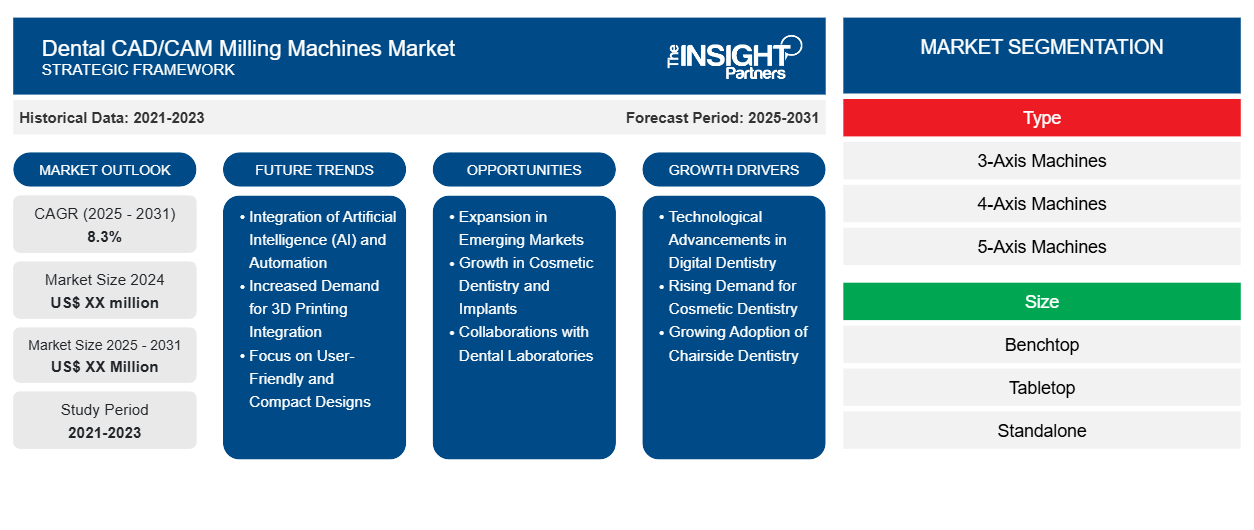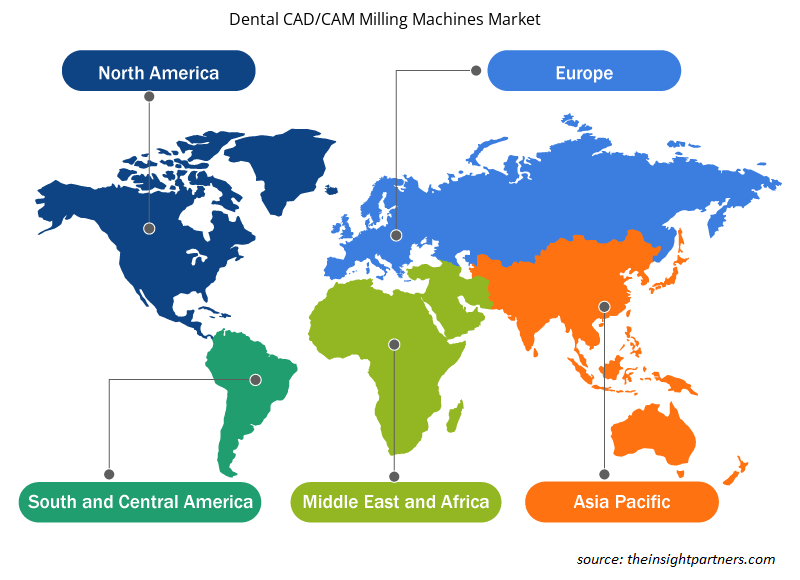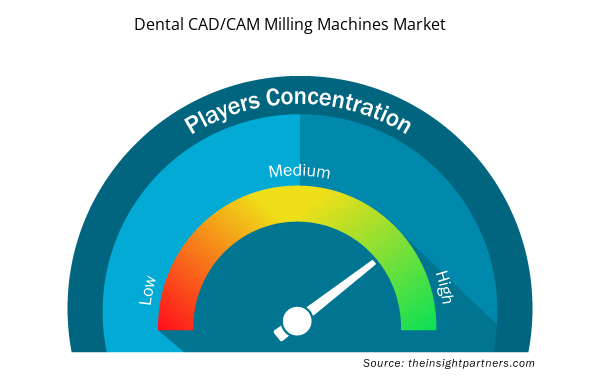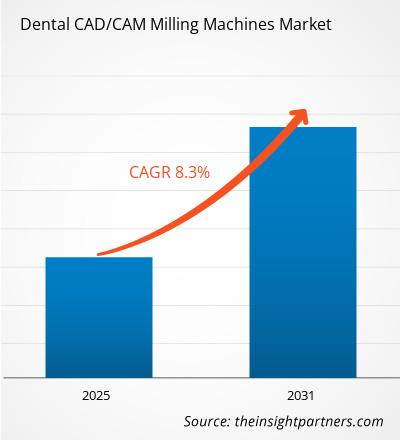Der Markt für Dental-CAD/CAM-Fräsmaschinen wird voraussichtlich von 2025 bis 2031 eine durchschnittliche jährliche Wachstumsrate (CAGR) von 8,3 % verzeichnen, wobei die Marktgröße von XX Millionen US-Dollar im Jahr 2024 auf XX Millionen US-Dollar im Jahr 2031 wachsen wird.
Der Bericht ist segmentiert nach Typ (3-Achsen-Maschinen, 4-Achsen-Maschinen und 5-Achsen-Maschinen); Größe (Tisch-, Tisch- und Standalone-Maschinen); Endbenutzer (Zahnmedizin, Medizin und andere). Die globale Analyse ist weiter auf regionaler Ebene und in die wichtigsten Länder unterteilt. Der Bericht bietet den Wert in USD für die oben genannte Analyse und Segmente.
Zweck des Berichts
Der Bericht Dental CAD/CAM Milling Machines Market von The Insight Partners zielt darauf ab, die aktuelle Situation und das zukünftige Wachstum sowie die wichtigsten treibenden Faktoren, Herausforderungen und Chancen zu beschreiben. Dies wird verschiedenen Geschäftspartnern Einblicke geben, wie zum Beispiel:
- Technologieanbieter/-hersteller: Um die sich entwickelnde Marktdynamik zu verstehen und die potenziellen Wachstumschancen zu kennen, damit sie fundierte strategische Entscheidungen treffen können.
- Investoren: Durchführung einer umfassenden Trendanalyse hinsichtlich der Marktwachstumsrate, der finanziellen Marktprognosen und der Chancen entlang der Wertschöpfungskette.
- Regulierungsbehörden: Sie regulieren Richtlinien und polizeiliche Aktivitäten auf dem Markt mit dem Ziel, Missbrauch zu minimieren, das Vertrauen der Anleger zu bewahren und die Integrität und Stabilität des Marktes aufrechtzuerhalten.
Dentale CAD/CAM-Fräsmaschinen Marktsegmentierung
Typ
- 3-Achs-Maschinen
- 4-Achs-Maschinen
- 5-Achs-Maschinen
Größe
- Tischgerät
- Tischplatte
- Standalone
Endbenutzer
- Zahnmedizin
- Medizin
- Sonstiges
Geographie
- Nordamerika
- Europa
- Asien-Pazifik
- Süd- und Mittelamerika
- Naher Osten und Afrika
Passen Sie diesen Bericht Ihren Anforderungen an
Sie erhalten kostenlos individuelle Anpassungen an jedem Bericht, einschließlich Teilen dieses Berichts oder einer Analyse auf Länderebene, eines Excel-Datenpakets sowie tolle Angebote und Rabatte für Start-ups und Universitäten.
Markt für zahnärztliche CAD/CAM-Fräsmaschinen: Strategische Einblicke

- Holen Sie sich die wichtigsten Markttrends aus diesem Bericht.Dieses KOSTENLOSE Beispiel umfasst eine Datenanalyse von Markttrends bis hin zu Schätzungen und Prognosen.
Wachstumstreiber auf dem Markt für Dental-CAD/CAM-Fräsmaschinen
- Technologische Fortschritte in der digitalen Zahnheilkunde: Die wachsende Popularität der digitalen Zahnheilkunde ist einer der Hauptfaktoren, die zum Markt für CAD/CAM-Fräsmaschinen beitragen. Zahnarztpraxen nutzen Technologien für computergestütztes Design (CAD) und computergestützte Fertigung (CAM), um in sehr kurzer Zeit präzise und individuelle Restaurationen wie Kronen, Brücken und Veneers herzustellen. Diese Entwicklung erhöht die Genauigkeit der Behandlung und verringert den Zeitaufwand für die Herstellung, wodurch die Behandlungsergebnisse für die Patienten verbessert werden, was wiederum den Bedarf an CAD/CAM-Fräsmaschinen erhöht.
- Steigende Nachfrage nach kosmetischer Zahnheilkunde: Der Trend zu ästhetischen Zahnbehandlungen wird immer weiter verbreitet und dies führt zu schnelleren und effizienteren Zahnfrässystemen. Dies ist teilweise auf die Verfügbarkeit von CAD/CAM-Fräsmaschinen zurückzuführen, die die Herstellung hochwertiger und dennoch individueller Standardeinrichtungen für Patienten erleichtern, die dies wünschen, insbesondere in Ländern, in denen dieser Service leicht verfügbar ist und die Praktiker Veneers, Kronen, Inlays und Implantate einsetzen können.
- Zunehmende Nutzung der Chairside-Zahnmedizin: Dieser Chairside-Ansatz, der es dem Patienten ermöglicht, sofortige Restaurationen mithilfe von CAD/CAM-Einheiten zu erhalten, fördert den Kauf von CAD/CAM-Fräsmaschinen für Zahnärzte. So können Kronen, Veneers und Brücken für die Patienten überall auf dem gleichen roten Teppich hergestellt werden, was den Grad der Patientenzufriedenheit erhöht. Da die Patienten jedoch schnellere, bessere und bequemere Restaurationen erhalten müssen, müssen Praxen Fräsmaschinen kaufen, damit qualitativ hochwertige Restaurationen in den eigenen vier Wänden durchgeführt werden können und nicht an ein Labor geschickt oder ausgelagert werden müssen.
Markttrends für Dental-CAD/CAM-Fräsmaschinen
- Integration von künstlicher Intelligenz (KI) und Automatisierung: Darüber hinaus gibt es einen bemerkenswerten Anstieg auf dem Markt für CAD/CAM-Frässysteme für die Implantologie, d. h. die Integration von künstlicher Intelligenz und Automatisierung. Diese technologischen Fortschritte haben die Genauigkeit, Effizienz und Benutzerfreundlichkeit der Fräsmaschinen verbessert. KI-Algorithmen würden beispielsweise dazu beitragen, die Design- und Fräsprozesse zu verbessern, sodass weniger oder keine menschlichen Fehler auftreten, was die Produktion beschleunigt und zu konsistenten Ergebnissen bei der Zahnrestauration führt.
- Erhöhte Nachfrage nach 3D-Druckintegration: Mit der kontinuierlichen Verbesserung der 3D-Drucktechnologie gibt es eine neue Tendenz zur Konvergenz der Technologie mit CAD/CAM-Frässystemen. Dies bietet die Möglichkeit, dekorative Garageneinlagen zu verwenden sowie hochpräzise Zahnkronen oder -abgüsse herzustellen. Das gemeinsame Fräsen und 3D-Drucken von Zahnteilen fördert die Leistungsfähigkeit und Funktionalität von Zahnkliniken und Laboren.
- Fokus auf benutzerfreundliche und kompakte Designs: Es gibt jedoch einen Paradigmenwechsel hin zur Verwendung kompakterer, einfach zu bedienender CAD/CAM-Fräsmaschinen für Zahnärzte, der es kleinen bis mittelgroßen Zahnkliniken ermöglicht, fortschrittliche Technologien zu nutzen. Es werden Systeme entwickelt, die über benutzerfreundliche Bedienelemente verfügen und weniger Platz beanspruchen. Ihr Design ermöglicht es Zahnärzten, die Geräte mit wenig oder gar keiner Schulung zu verwenden. Ein solcher Trend trägt dazu bei, den Zugang zu fortschrittlichen Fräsgeräten zu erleichtern, da er nicht nur auf anspruchsvolle Zahnärzte abzielt.
Marktchancen für Dental-CAD/CAM-Fräsmaschinen
- Expansion in Schwellenmärkte: Neue Regionen auf den globalen Märkten, insbesondere in Asien, Lateinamerika und Afrika, konzentrieren sich stark auf das Wachstum im Markt für CAD/CAM-Fräsmaschinen für Zahnärzte. Da Praxen in diesen Ländern auf digitale Zahnheilkunde umsteigen und Patienten nach erschwinglichen und dennoch hochwertigen Restaurationen suchen, besteht ein wachsender Bedarf an effizienten, einfachen Frässystemen. Solche Märkte können von den Unternehmen mithilfe kostengünstiger und fortschrittlicher technologischer Lösungen erreicht werden.
- Wachstum in der kosmetischen Zahnheilkunde und bei Implantaten: Die veränderte Einstellung zur kosmetischen Zahnheilkunde und den damit verbundenen Implantaten, insbesondere die steigenden Bedürfnisse der Patienten, bietet eine sehr attraktive Gelegenheit für die Herstellung von CAD-CAM-Fräsmaschinen. Aufgrund dieser Tendenz kaufen Praktiker anspruchsvolle Fräsgeräte, mit denen zeitgemäße und verschönernde Designs hergestellt werden können, da immer mehr Patienten nach individuellen und restaurativen Behandlungsansätzen suchen. Diese Möglichkeit streben die Hersteller an, um in den wachsenden Bereich der ästhetischen Zahnheilkunde und Implantologie einzusteigen.
- Zusammenarbeit mit Dentallaboren: Eine Partnerschaft mit Dentallaboren ist einer der optimistischsten Aspekte für das Wachstum des Marktes für CAD/CAM-Fräsmaschinen für den Dentalbereich. Viele Dentaldrehmaschinen, darunter auch eine ganze Reihe Dentallabore, rüsten ihre Systeme auf oder haben sie bereits aufgerüstet, um Leistung und Präzision zu verbessern. Daher könnten die Hersteller mit Laboren dieser Art spezifische Lösungen oder Servicepakete entwerfen und entwickeln und letztendlich können so gute Arbeitsbeziehungen aufrechterhalten und Geschäftsentwicklungsmöglichkeiten auf dem Markt geschaffen werden, da der Bedarf an zusätzlichen Verfahren zur Zahnrestauration steigt.
Regionale Einblicke in den Markt für Dental-CAD/CAM-Fräsmaschinen
Die regionalen Trends und Faktoren, die den Markt für Dental-CAD/CAM-Fräsmaschinen im Prognosezeitraum beeinflussen, wurden von den Analysten von Insight Partners ausführlich erläutert. In diesem Abschnitt werden auch die Marktsegmente und die Geografie für Dental-CAD/CAM-Fräsmaschinen in Nordamerika, Europa, im asiatisch-pazifischen Raum, im Nahen Osten und Afrika sowie in Süd- und Mittelamerika erörtert.

- Erhalten Sie regionale Daten zum Markt für Dental-CAD/CAM-Fräsmaschinen
Marktbericht zu Dental-CAD/CAM-Fräsmaschinen – Umfang
| Berichtsattribut | Details |
|---|---|
| Marktgröße im Jahr 2024 | XX Millionen US-Dollar |
| Marktgröße bis 2031 | XX Millionen US-Dollar |
| Globale CAGR (2025 - 2031) | 8,3 % |
| Historische Daten | 2021-2023 |
| Prognosezeitraum | 2025–2031 |
| Abgedeckte Segmente | Nach Typ
|
| Abgedeckte Regionen und Länder | Nordamerika
|
| Marktführer und wichtige Unternehmensprofile |
|
Marktteilnehmerdichte für Dental-CAD/CAM-Fräsmaschinen: Auswirkungen auf die Geschäftsdynamik verstehen
Der Markt für Dental-CAD/CAM-Fräsmaschinen wächst rasant. Dies wird durch die steigende Nachfrage der Endnutzer aufgrund von Faktoren wie sich entwickelnden Verbraucherpräferenzen, technologischen Fortschritten und einem größeren Bewusstsein für die Vorteile des Produkts vorangetrieben. Mit der steigenden Nachfrage erweitern Unternehmen ihr Angebot, entwickeln Innovationen, um die Bedürfnisse der Verbraucher zu erfüllen, und nutzen neue Trends, was das Marktwachstum weiter ankurbelt.
Die Marktteilnehmerdichte bezieht sich auf die Verteilung von Firmen oder Unternehmen, die in einem bestimmten Markt oder einer bestimmten Branche tätig sind. Sie gibt an, wie viele Wettbewerber (Marktteilnehmer) in einem bestimmten Marktraum im Verhältnis zu seiner Größe oder seinem gesamten Marktwert vorhanden sind.
Die wichtigsten auf dem Markt für Dental-CAD/CAM-Fräsmaschinen tätigen Unternehmen sind:
- Amann Girrbach
- Dentsply Sirona
- Planmeca OY
- Ivoclar Vivadent
- 3M Unternehmen
Haftungsausschluss : Die oben aufgeführten Unternehmen sind nicht in einer bestimmten Reihenfolge aufgeführt.

- Überblick über die wichtigsten Akteure auf dem Markt für Dental-CAD/CAM-Fräsmaschinen
Wichtige Verkaufsargumente
- Umfassende Abdeckung: Der Bericht deckt die Analyse von Produkten, Dienstleistungen, Typen und Endbenutzern des Marktes für Dental-CAD/CAM-Fräsmaschinen umfassend ab und bietet einen ganzheitlichen Überblick.
- Expertenanalyse: Der Bericht basiert auf dem umfassenden Verständnis von Branchenexperten und Analysten.
- Aktuelle Informationen: Der Bericht stellt durch die Abdeckung aktueller Informationen und Datentrends Geschäftsrelevanz sicher.
- Anpassungsoptionen: Dieser Bericht kann angepasst werden, um spezifische Kundenanforderungen zu erfüllen und die Geschäftsstrategien optimal anzupassen.
Der Forschungsbericht zum Markt für Dental-CAD/CAM-Fräsmaschinen kann daher dabei helfen, die Branchensituation und Wachstumsaussichten zu entschlüsseln und zu verstehen. Obwohl es einige berechtigte Bedenken geben kann, überwiegen die allgemeinen Vorteile dieses Berichts tendenziell die Nachteile.
- Historische Analyse (2 Jahre), Basisjahr, Prognose (7 Jahre) mit CAGR
- PEST- und SWOT-Analyse
- Marktgröße Wert/Volumen – Global, Regional, Land
- Branche und Wettbewerbsumfeld
- Excel-Datensatz



Report Coverage
Revenue forecast, Company Analysis, Industry landscape, Growth factors, and Trends

Segment Covered
This text is related
to segments covered.

Regional Scope
North America, Europe, Asia Pacific, Middle East & Africa, South & Central America

Country Scope
This text is related
to country scope.
Häufig gestellte Fragen
The market is expected to grow at a CAGR of 8.3%
The final report will duly include market size and projection estimates for all the segments from 2021 to 2031, along with a revenue share and compound annual growth rate (%) for the regional
/
country-wise market wherein 2021-2022 are the historic years, 2023 is considered to be the base year, and the forecast will be provided till 2031, along with CAGR (%)
The North America region accounts for highest revenue share dental CAD/CAM milling machines market
Asia Pacific is estimated to grow at the highest CAGR over the forecast year (2023 - 2031)
The Dental CAD/CAM Milling Machines Market is estimated to witness a CAGR of 8.3% from 2023 to 2031
Technological advancements in digital dentistry and rising demand for cosmetic dentistry are the major factors boosting the dental CAD/CAM milling machines market growth
Trends and growth analysis reports related to Life Sciences : READ MORE..
1. Amann Girrbach
2. Dentsply Sirona
3. Planmeca OY
4. Ivoclar Vivadent
5. 3M Company
6. Straumann
7. Zimmer
8. Dentium
9. Roland DGA Corporation
10. DATRON
The Insight Partners performs research in 4 major stages: Data Collection & Secondary Research, Primary Research, Data Analysis and Data Triangulation & Final Review.
- Data Collection and Secondary Research:
As a market research and consulting firm operating from a decade, we have published and advised several client across the globe. First step for any study will start with an assessment of currently available data and insights from existing reports. Further, historical and current market information is collected from Investor Presentations, Annual Reports, SEC Filings, etc., and other information related to company’s performance and market positioning are gathered from Paid Databases (Factiva, Hoovers, and Reuters) and various other publications available in public domain.
Several associations trade associates, technical forums, institutes, societies and organization are accessed to gain technical as well as market related insights through their publications such as research papers, blogs and press releases related to the studies are referred to get cues about the market. Further, white papers, journals, magazines, and other news articles published in last 3 years are scrutinized and analyzed to understand the current market trends.
- Primary Research:
The primarily interview analysis comprise of data obtained from industry participants interview and answers to survey questions gathered by in-house primary team.
For primary research, interviews are conducted with industry experts/CEOs/Marketing Managers/VPs/Subject Matter Experts from both demand and supply side to get a 360-degree view of the market. The primary team conducts several interviews based on the complexity of the markets to understand the various market trends and dynamics which makes research more credible and precise.
A typical research interview fulfils the following functions:
- Provides first-hand information on the market size, market trends, growth trends, competitive landscape, and outlook
- Validates and strengthens in-house secondary research findings
- Develops the analysis team’s expertise and market understanding
Primary research involves email interactions and telephone interviews for each market, category, segment, and sub-segment across geographies. The participants who typically take part in such a process include, but are not limited to:
- Industry participants: VPs, business development managers, market intelligence managers and national sales managers
- Outside experts: Valuation experts, research analysts and key opinion leaders specializing in the electronics and semiconductor industry.
Below is the breakup of our primary respondents by company, designation, and region:

Once we receive the confirmation from primary research sources or primary respondents, we finalize the base year market estimation and forecast the data as per the macroeconomic and microeconomic factors assessed during data collection.
- Data Analysis:
Once data is validated through both secondary as well as primary respondents, we finalize the market estimations by hypothesis formulation and factor analysis at regional and country level.
- Macro-Economic Factor Analysis:
We analyse macroeconomic indicators such the gross domestic product (GDP), increase in the demand for goods and services across industries, technological advancement, regional economic growth, governmental policies, the influence of COVID-19, PEST analysis, and other aspects. This analysis aids in setting benchmarks for various nations/regions and approximating market splits. Additionally, the general trend of the aforementioned components aid in determining the market's development possibilities.
- Country Level Data:
Various factors that are especially aligned to the country are taken into account to determine the market size for a certain area and country, including the presence of vendors, such as headquarters and offices, the country's GDP, demand patterns, and industry growth. To comprehend the market dynamics for the nation, a number of growth variables, inhibitors, application areas, and current market trends are researched. The aforementioned elements aid in determining the country's overall market's growth potential.
- Company Profile:
The “Table of Contents” is formulated by listing and analyzing more than 25 - 30 companies operating in the market ecosystem across geographies. However, we profile only 10 companies as a standard practice in our syndicate reports. These 10 companies comprise leading, emerging, and regional players. Nonetheless, our analysis is not restricted to the 10 listed companies, we also analyze other companies present in the market to develop a holistic view and understand the prevailing trends. The “Company Profiles” section in the report covers key facts, business description, products & services, financial information, SWOT analysis, and key developments. The financial information presented is extracted from the annual reports and official documents of the publicly listed companies. Upon collecting the information for the sections of respective companies, we verify them via various primary sources and then compile the data in respective company profiles. The company level information helps us in deriving the base number as well as in forecasting the market size.
- Developing Base Number:
Aggregation of sales statistics (2020-2022) and macro-economic factor, and other secondary and primary research insights are utilized to arrive at base number and related market shares for 2022. The data gaps are identified in this step and relevant market data is analyzed, collected from paid primary interviews or databases. On finalizing the base year market size, forecasts are developed on the basis of macro-economic, industry and market growth factors and company level analysis.
- Data Triangulation and Final Review:
The market findings and base year market size calculations are validated from supply as well as demand side. Demand side validations are based on macro-economic factor analysis and benchmarks for respective regions and countries. In case of supply side validations, revenues of major companies are estimated (in case not available) based on industry benchmark, approximate number of employees, product portfolio, and primary interviews revenues are gathered. Further revenue from target product/service segment is assessed to avoid overshooting of market statistics. In case of heavy deviations between supply and demand side values, all thes steps are repeated to achieve synchronization.
We follow an iterative model, wherein we share our research findings with Subject Matter Experts (SME’s) and Key Opinion Leaders (KOLs) until consensus view of the market is not formulated – this model negates any drastic deviation in the opinions of experts. Only validated and universally acceptable research findings are quoted in our reports.
We have important check points that we use to validate our research findings – which we call – data triangulation, where we validate the information, we generate from secondary sources with primary interviews and then we re-validate with our internal data bases and Subject matter experts. This comprehensive model enables us to deliver high quality, reliable data in shortest possible time.

 Holen Sie sich ein kostenloses Muster für diesen Bericht
Holen Sie sich ein kostenloses Muster für diesen Bericht